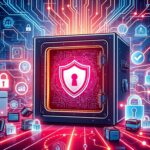Did you know that CISSP Domain 3, which focuses on Security Architecture and Engineering, makes up 13% of the CISSP exam? This big part shows how key it is to know about security architecture in info security. As tech keeps changing, IT pros need to get good at the ideas and ways in Domain 3 to fight off cyber threats.
We’ll look into CISSP Domain 3’s structure, covering its main parts. This includes secure design rules, security models, and how they help make a strong security plan. Learning about security engineering helps you set up strong plans that meet your company’s info security aims.
Key Takeaways
- CISSP Domain 3 accounts for 13% of the CISSP certification exam.
- Understanding security architecture is crucial for developing effective defenses against cyber threats.
- Key security models include Bell–LaPadula, Biba, and Clark–Wilson, each serving different aspects of information security.
- Secure design principles help create robust security architectures through concepts like least privilege and defense in depth.
- Knowledge of covert channels and their implications is vital for maintaining data confidentiality and integrity.
Understanding Security Architecture
Security architecture is like a blueprint for keeping an organization safe. It shows how security policies fit with the company’s goals. A good security plan protects against threats and follows the law.
Having a solid security framework makes your company stronger against dangers. It helps keep your data and systems safe.
Definition and Importance of Security Architecture
Security architecture is about protecting an organization’s information. It’s like a map for keeping data safe. This plan helps in making cybersecurity strategies that fit the company’s needs.
It reduces risks and follows the law. This makes sure your operations are secure. A clear security plan helps in using security measures well, keeping everything safe.
Components of Effective Security Architecture
Knowing what makes up a good security plan is key. Important parts include:
- Security Policies: These are the rules for keeping things safe.
- Standards: These are the guidelines for following the policies.
- Procedures: These are the step-by-step guides for daily security tasks.
- Technologies: These are the tools and systems for watching over and fixing security issues.
Looking at these parts helps in making a strong security plan. Using different security tools and methods makes your cybersecurity better. A well-coordinated security plan can handle new threats better.
| Component | Description | Importance |
|---|---|---|
| Security Policies | Rules and guidelines for protecting information assets. | Clears up who does what in security. |
| Standards | Specifications for following policies. | Makes sure everything is done the same way. |
| Procedures | How to follow the standards step by step. | Gives clear instructions for daily tasks. |
| Technologies | Software and hardware for security tasks. | Helps in finding and fixing security problems. |
Key Principles of Security Engineering
Understanding the key principles of security engineering is crucial for creating effective systems. These systems protect sensitive information. This section covers the basics of security models, security design principles, and the engineering lifecycle in the information security process.
Fundamental Concepts of Security Models
Security models are the framework for protecting information assets. They focus on three key areas: confidentiality, integrity, and availability. These areas form the basis of security engineering practices.
Different models, like Bell-LaPadula and Biba, guide how to handle sensitive data. They ensure that only authorized individuals can access the information. This keeps the data accurate and available when needed.
Security Design Principles
Sound security design principles are essential for creating strong systems. Key principles include:
- Defense in Depth: Using multiple layers of security controls to protect against various threats.
- Principle of Least Privilege: Giving users only the access they need for their roles to reduce risks.
- Fail-Safe Stance: Designing systems that default to a secure state in case of failures.
These principles help professionals build secure architectures. They ensure systems can withstand attacks and keep administrative tasks manageable.
The Engineering Lifecycle in Information Security
The engineering lifecycle includes planning, development, implementation, and maintenance of security measures. Continuous improvement is vital. Organizations must regularly assess their systems through risk assessments and security audits.
This proactive approach helps teams adapt to new threats. It also ensures necessary changes are made to security engineering practices.
CISSP Domain 3 Overview
The CISSP Domain 3 overview gives us a key look at security architecture’s role in the CISSP certification. It shows how security architecture works with business goals. This is crucial for good information security governance.
Scope and Relevance of CISSP Domain 3
CISSP Domain 3 deals with security architecture and engineering, making up 13% of the CISSP exam. This big part shows how important it is in security management. To pass, candidates need to understand the main ideas of different areas, like Security and Risk Management and Asset Security.
Mapping Security Architecture to Business Goals
Security architecture must match business goals to help achieve company objectives. Knowing how information security governance works helps professionals. They can make sure security efforts protect important assets and help the company succeed.
This involves finding out what the business needs and adding those to security plans. This way, they stay in line with industry rules and handle security risks well.
Access Control Mechanisms
Access control is key to keeping sensitive info safe in companies. Knowing the different types, how to set them up, and the hurdles they pose can boost your security. It’s important to follow best practices for access control to protect against unauthorized access.
Types of Access Control
There are many types of access control you can use, each for different needs:
- Discretionary Access Control (DAC): Users can control who gets to their stuff.
- Mandatory Access Control (MAC): A central authority decides who gets to what based on rules.
- Role-Based Access Control (RBAC): Access is based on a person’s job in the company, making it easier to manage.
Implementation Strategies for Access Control
To improve your implementation strategies for access control, follow these steps:
- Do a deep check of who has access to what to find out what’s missing.
- Make clear rules about who gets to do what with access rights.
- Use tools to make getting access easier and keep things in line.
- Keep an eye on and update access controls as your company grows.
Access Control Challenges and Best Practices
Companies face big challenges in managing access control, especially with the fast pace of today’s work world. Some big hurdles are:
- Keeping remote access safe without letting bad guys in.
- Checking who’s really logging in to keep out unauthorized users.
To tackle these issues, follow these security best practices:
- Use more than one way to prove who you are to make identity checks stronger.
- Teach your team about the importance of access control rules and how to follow them.
- Watch and record who’s trying to get in to spot and stop any problems.
Compliance Frameworks and Security Policies
In today’s digital world, knowing about compliance frameworks is key for companies. These frameworks give important rules for your security policies. They help you follow laws and keep your data safe.
Learning about GDPR, HIPAA, and PCI-DSS is important. It helps your company protect data and keep privacy strong.
Understanding Compliance Frameworks
Compliance frameworks are like blueprints for following laws and rules. They set standards for security, promoting honesty and responsibility. By using these frameworks, you can lower risks and avoid big fines.
The Role of Security Policies in Governance
Good security policies are essential for good governance. They explain how to handle security risks and who is responsible. This way, everyone knows their part in keeping things safe.
They also make sure risk management is a top priority. With clear policies, you can handle complex rules and stay compliant. This also strengthens your security.
Risk Management in Security Architecture
Effective risk management is key in security architecture. It helps spot and tackle threats and vulnerabilities that could harm systems and data. Knowing the risks lets organizations set up strong security and stay resilient.
Identifying Threats and Vulnerabilities
In cybersecurity, understanding threats and vulnerabilities is the first step to protect your assets. Common threats include:
- Malware and ransomware attacks
- Phishing and social engineering tactics
- Insider threats and human error
- Advanced persistent threats (APTs)
Regular assessments help you grasp the risks your organization faces. Tools like automated scanning and manual testing find weaknesses that need fixing.
Risk Assessment Methodologies
After spotting risks, a detailed risk assessment is vital. Two main methods are:
- Qualitative Risk Assessment: Uses experience and intuition to rank risks as high, medium, or low.
- Quantitative Risk Assessment: Uses numbers and data to measure risks mathematically.
The right method depends on your organization’s needs. It helps focus on the most critical risks first.
Countermeasure Selection and Implementation
The final step is picking the right cybersecurity countermeasures to tackle risks. Key strategies include:
| Countermeasure Type | Description | Implementation Example |
|---|---|---|
| Technical Controls | Tools and software to block threats | Firewalls, intrusion detection systems |
| Administrative Controls | Policies and procedures for access and behavior | Security training and awareness programs |
| Physical Controls | Steps to protect physical assets | Access control systems, surveillance cameras |
Keeping an eye on these countermeasures’ success is crucial. Regular updates to your risk management plans help keep your architecture secure.

Emerging Technologies Impacting Security Engineering
Security engineering is changing fast, thanks to new technologies. These changes help improve how we protect our data and systems. Knowing about these new tools can make your organization stronger against threats.
Impact of Quantum Computing
Quantum computing is a big change for security. It can break some encryption methods quickly. To stay safe, companies need to switch to new, quantum-proof ways to protect data.
Adoption of Blockchain Technology
Blockchain is known for its strong security. It keeps data safe and lets everyone see changes. This is great for keeping data safe in supply chains and digital deals.
Role of Artificial Intelligence in Security
Artificial intelligence is key in today’s security. It uses smart algorithms to find threats fast. By using AI, you can stay ahead of cyber attacks and keep your data safe.
| Technology | Impact on Security | Applications |
|---|---|---|
| Quantum Computing | Challenges current encryption standards | Future-proofing sensitive data protection |
| Blockchain Technology | Enhances data integrity and trust | Digital contracts, supply chain security |
| Artificial Intelligence | Automates threat detection and response | Predictive analytics, anomaly detection |
Security Awareness Training
In today’s digital world, companies face many cybersecurity threats. It’s key to have security awareness training to build a strong security culture. This training helps teach employees how to spot and handle security risks.
By having ongoing security programs, employees learn more and can act wisely when faced with risks.
Importance of Security Training in Organizations
Training is very important. Employees are a big part of a company’s security. When they know about cybersecurity, they can spot phishing and other dangers.
This knowledge helps reduce risks that could lead to big security breaches.
Effective Methods for Security Awareness Programs
Using different ways to teach security awareness makes programs more interesting. Using real-life examples helps employees understand and remember better. Games and interactive learning make training fun and effective. Here are some good methods:
- Regular workshops on the latest cybersecurity trends.
- Simulated phishing campaigns to test and improve knowledge.
- Online modules for learning at your own speed.
- Feedback and assessments to check how well employees understand.
Investing in good cybersecurity education makes a company’s security stronger. By using many and fun ways to teach, employees are ready to face threats. They also help keep the company’s security strong.
Security Metrics and Audit Monitoring
In cybersecurity, setting up good security metrics and audit monitoring is key. It helps check if security efforts are working well. This ensures they follow the best cybersecurity practices. Also, it helps keep up with rules and find ways to get better.
Establishing Security Metrics for Evaluation
Good security metrics give clear views. They help spot and measure risks in security setups. They track things like:
- Incident response times
- Threat detection rates
- How often security breaches happen
- What audits find and how we fix it
By watching these, we can find weak spots and plan to fix them. Knowing about identity and access management helps protect against unauthorized access too.
Best Practices for Ongoing Audit and Monitoring
Here are some top tips for better audit monitoring:
- Keep an eye on things all the time to catch problems fast.
- Do regular security checks and look at logs to get important info.
- Use automated tools to keep monitoring steady.
- Have clear reports on audits to tell others what’s happening.
Always check and update security plans to stay ahead. This keeps assets safe and follows rules better. Good audit monitoring shows attack patterns and helps make policies stronger, keeping info safe.

| Security Metrics | Purpose | Example Measurement |
|---|---|---|
| Incident Response Time | Evaluate responsiveness | Average time to resolve an incident |
| Threat Detection Rate | Measure effectiveness of defenses | Percentage of threats detected before breach |
| Compliance Audit Results | Ensure adherence to standards | Number of reported compliance issues |
| Access Control Failures | Assess security of access controls | Number of unauthorized access attempts |
Incident Response Planning
Effective incident response planning is key for protecting digital assets. An incident response plan helps manage security incidents. This ensures quick recovery and less damage. Knowing what’s in such a plan is crucial for your organization’s safety.
Components of an Effective Incident Response Plan
An incident response plan must have several important parts. These parts help handle security threats well. They include:
- Preparation: Setting up and training an incident response team.
- Detection: Using systems to spot possible incidents fast.
- Analysis: Looking into and figuring out how bad the incidents are.
- Containment: Taking quick steps to stop the incident from getting worse.
- Eradication: Getting rid of what caused the incident to stop it from happening again.
- Recovery: Getting systems back to normal and checking they’re working right.
Each part is vital for a good incident response plan. They help manage incidents well, keeping organizations safe from threats.
Real-world Applications of Incident Response Strategies
Real-world examples show how incident response plans help. For instance:
- Data Breaches: Plans help manage and lessen the impact of data breaches, saving money and reputation.
- Ransomware Attacks: Quick actions can stop ransomware and get data back, cutting downtime.
- Phishing Attempts: Teaching employees to spot phishing can strengthen the plan against these attacks.
Using incident response strategies boosts an organization’s ability to deal with incidents. It shows their dedication to staying safe online.
Challenges in Security Architecture and Engineering
The world of security architecture faces many challenges. These can harm the safety and privacy of data. It’s key for companies to know these challenges to strengthen their defenses.
Many security weaknesses exist in architectures. These can be used by bad actors. So, it’s important to fix current issues and stay ready for new threats.
Common Vulnerabilities in Security Architectures
Companies often find several common weaknesses in their security setups. These can make systems vulnerable. Some of these issues include:
- Inadequate encryption measures, which may fail to protect sensitive data.
- Misconfigured security settings that can easily be leveraged by attackers.
- Outdated software and hardware components vulnerable to known exploits.
- Poorly defined access controls allowing unauthorized access to resources.
- Insufficient monitoring and incident response capabilities, leading to delayed reactions to breaches.
Addressing the Challenges of Remote Workforces
Remote work brings new security challenges. Keeping systems safe while working from anywhere needs a detailed plan:
- Implement comprehensive VPN solutions to encrypt data transmission.
- Adopt multi-factor authentication to strengthen user identity verification.
- Regularly conduct security training to educate employees on emerging threats and safe practices.
- Utilize endpoint security measures to protect devices used for remote work.
- Develop policies for secure data access and sharing to mitigate risks associated with remote collaborations.
| Vulnerability Type | Description | Potential Impact |
|---|---|---|
| Inadequate Encryption | Failure to encrypt sensitive data at rest or in transit. | Data breaches leading to exposure of confidential information. |
| Misconfigured Settings | Improper security settings on firewalls and applications. | Easier exploitation by attackers, increasing risk of breaches. |
| Outdated Components | Running unsupported software versions with known vulnerabilities. | Increased likelihood of attacks leveraging old exploits. |
| Poor Access Control | Weak policies regarding user permissions and access levels. | Unauthorized access, resulting in data theft or manipulation. |
| Insufficient Monitoring | Lack of adequate logging and monitoring solutions. | Delayed threat detection and response, exacerbating damage. |
Fixing these weaknesses and dealing with remote work issues helps companies stay safe. This way, they can face new security threats better.
Conclusion
In this overview of CISSP Domain 3, you’ve learned about key parts of security architecture and engineering. This summary shows you how to use this knowledge to make strong cybersecurity practices. You now know how to apply these principles to your organization’s security.
We talked about important topics like access control and compliance. We also looked at how new technologies affect security. In today’s fast-changing digital world, good security architecture is crucial. This conclusion urges you to make your organization’s goals stronger by following the best cybersecurity practices.
Remember the important points from this article as you continue to improve your cybersecurity. Keeping your organization’s assets safe is a constant task. By using the principles we discussed, you’ll stay ahead in the complex world of cybersecurity.
FAQ
What is the significance of CISSP Domain 3 in information security?
CISSP Domain 3 is all about security architecture and engineering. It’s key for IT pros. It helps them defend against attacks and keep their info safe.
What are the core components of effective security architecture?
Good security architecture has clear policies and standards. It aligns controls with business goals. This protects against threats and follows rules.
Can you explain the fundamental concepts of security models?
Security models focus on confidentiality, integrity, and availability. These basics guide the making of secure systems.
What are the major types of access control mechanisms?
There are DAC, MAC, and RBAC access controls. Each offers different security levels and management ease for protecting data.
Why are compliance frameworks essential in security architecture?
Frameworks like GDPR and PCI-DSS are key. They help create strong security policies and guide organizations in following rules.
How does risk management fit into security architecture?
Risk management starts with finding threats and vulnerabilities. It uses methods to assess risks and protect systems.
What emerging technologies should organizations be aware of regarding security engineering?
Know about quantum computing, blockchain, and AI in security. These techs can change security practices and improve data safety.
How important is security awareness training for employees?
Training is very important for a secure work culture. It helps employees deal with threats and keeps the company safe.
What role do security metrics and audit monitoring play in information security?
Metrics and monitoring check if security works. They help find areas for improvement and keep things compliant.
What are the key components of an effective incident response plan?
A good plan has preparation, detection, and response steps. It helps manage incidents and learn from them.
What challenges arise in security architecture due to remote workforces?
Remote work brings access and data protection issues. Companies must find ways to keep data safe no matter where people work.
Source Links
CISSP Domain 3: A Comprehensive Security Architecture Guide
25 New Technology Trends for 2025 | Emerging Technologies 2025
Top Cybersecurity Certifications You Should Know About as a Developer
- The Latest IT News You Can’t Miss Today
- Discover AI Innovations Revolutionizing Computing
- Boost Your Internet Speed: Advanced Techniques
- I Figured Out Why Your Internet is Slow and How to Fix It Fast
- How to Optimize Your Internet Experience



